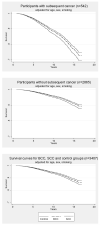Survival after squamous cell and basal cell carcinoma of the skin: A retrospective cohort analysis
- PMID: 25598534
- PMCID: PMC4478145
- DOI: 10.1002/ijc.29436
Survival after squamous cell and basal cell carcinoma of the skin: A retrospective cohort analysis
Abstract
A retrospective cohort analysis of survival after keratinocyte cancer (KC) was conducted using data from a large, population-based case-control study of KC in New Hampshire. The original study collected detailed information during personal interviews between 1993 and 2002 from individuals with squamous (SCC) and basal (BCC) cell carcinoma, and controls identified through the Department of Transportation, frequency-matched on age and sex. Participants without a history of non-skin cancer at enrolment were followed as a retrospective cohort to assess survival after either SCC or BCC, or a reference date for controls. Through 2009, cancers were identified from the New Hampshire State Cancer Registry and self-report; death information was obtained from state death certificate files and the National Death Index. There were significant differences in survival between those with SCC, BCC and controls (p = 0.040), with significantly greater risk of mortality after SCC compared to controls (adjusted hazard ratio [HR] 1.25; 95% confidence interval 1.01-1.54). Mortality after BCC was not significantly altered (HR 0.96; 95% CI 0.77-1.19). The excess mortality after SCC persisted after adjustment for numerous personal risk factors including time-varying non-skin cancer occurrence, age, sex and smoking. Survival from the date of the intervening cancer, however, did not vary (HR for SCC 0.98; 95% CI 0.70-1.38). Mortality also remained elevated when individuals with subsequent melanoma were excluded (HR for SCC 1.30; 95% CI 1.05-1.61). Increased mortality after SCC cannot be explained by the occurrence of intervening cancers, but may reflect a more general predisposition to life threatening illness that merits further investigation.
Keywords: basal cell carcinoma; squamous cell carcinoma; survival.
© 2015 UICC.
Figures
References
-
- Rogers HW, Weinstock MA, Harris AR, Hinckley MR, Feldman SR, Fleischer AB, et al. Incidence estimate of nonmelanoma skin cancer in the United States, 2006. Arch Dermatol. 2010;146:283–7. - PubMed
-
- Miller DL, Weinstock MA. Nonmelanoma skin cancer in the United States: incidence. J Am Acad Dermatol. 1994;30:774–8. - PubMed
-
- Birch-Johansen F, Jensen A, Mortensen L, Olesen AB, Kjaer SK. Trends in the incidence of nonmelanoma skin cancer in Denmark 1978-2007: Rapid incidence increase among young Danish women. Int J Cancer. 2010;127:2190–8. - PubMed
-
- Lindelof B, Sigurgeirsson B, Wallberg P, Eklund G. Occurrence of other malignancies in 1973 patients with basal cell carcinoma. J Am Acad Dermatol. 1991;25:245–8. - PubMed
-
- Teppo L, Dickman PW, Hakulinen T, Luostarinen T, Pukkala E, Sankila R, et al. Cancer patient survival--patterns, comparisons, trends--a population-based Cancer Registry study in Finland. Acta Oncol. 1999;38:283–94. - PubMed
Publication types
MeSH terms
Grants and funding
LinkOut - more resources
Full Text Sources
Other Literature Sources
Medical
Research Materials


